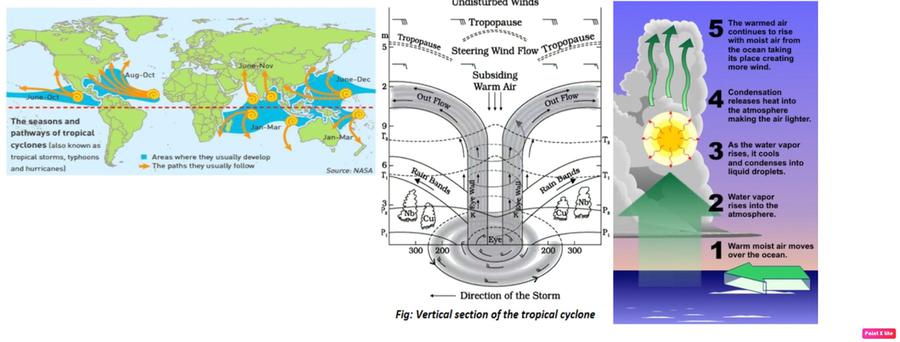Mains Daily Question
March 19, 2024
Q1. How are tropical cyclones formed? Explain the weather conditions associated with them. (15 Marks, 250 Words)
|
Approach for the answer: Understanding the structuring of the answer: The question has two parts and in the first part the question talks about the formation of tropical cyclones and in the second part it talks about the weather conditions associated with the tropical cyclones. Introduction: Type 1: We can introduce the question by giving the definition of cyclones. Type 2: You can also mention a few of their general characteristics. Body: Heading 1: First explain the formation of the tropical cyclones with a neat labeled diagram. Heading 2: Explain the weather conditions associated with them. Conclusion: Type 1: We can conclude the answer by mentioning the significant impact of the cyclones on the climate conditions. Type 2: Write about measures that can be used to deal with the impact of cyclones. |
Answer: Cyclones are rapid inward air circulation around a low-pressure area. The air circulates in an anticlockwise direction in the Northern hemisphere and clockwise in the Southern hemisphere.
A tropical cyclone is a rapidly rotating storm system characterized by a low-pressure center, a closed low-level atmospheric circulation, strong winds, and a spiral arrangement of thunderstorms that produce heavy rain.
|
Formation of Tropical cyclones: |
Tropical cyclones generally form over warm waters near the equator (sea surface with temperature higher than 27° C).
Formation and Initial Development Stage
- The process begins when warm, moist air from the ocean's surface rises, creating an area of low pressure. This causes air from the surrounding high-pressure areas to flow in and warm up, resulting in more air rising.
- It encourages formation of massive vertical cumulus clouds due to convection with condensation of rising air above the ocean surface.
Mature Stage
- When a tropical storm intensifies, the air rises in vigorous thunderstorms and tends to spread out horizontally at the tropopause level.
- At this stage, the spiraling winds create multiple convective cells with successive calm and violent regions.
- The regions with cumulonimbus cloud (rising limbs of convective cell) formation are called rain bands below which intense rainfall occurs.
- The winds continue to increase in speed, forming an eye in the center of the cyclone, where air pressure is at its lowest. The difference in temperature between the warm, rising air and the cooler environment causes the air to become buoyant and rise.
Modification and Decay
- A tropical cyclone begins to weaken in terms of its central low pressure, internal warmth and extremely high speeds, as soon as its source of warm moist air begins to ebb or is abruptly cut off.
- This happens after its landfall or when it passes over cold waters.
|
Weather conditions associated with the tropical cyclones: |
- Wind: Cyclones have gale force winds with wind gusts of more than 90 km/h around their center. These winds can cause extensive property damage and turn airborne debris into potentially lethal missiles.
- For example, the 2018 Cyclone Titli caused widespread destruction in India, with wind speeds of up to 140 km/h.
- Rain: Heavy rainfall associated with the passage of a tropical cyclone can produce extensive flooding.
- For example, the 2019 Cyclone Fani brought heavy rainfall and flooding to parts of India, particularly in the states of Odisha and West Bengal.
- Storm surge: A tropical cyclone can cause the sea to rise well above the highest tide levels of the year when it comes ashore. These storm surges are caused mainly by strong onshore winds and reduced atmospheric pressure.
- For example, the 2020 Cyclone Amphan caused a storm surge of up to 3 meters along the eastern coast of India, causing significant damage.
Tropical cyclones are powerful atmospheric systems that form over the different regions of the earth. They can cause significant destruction. With climate change and global warming their intensity and frequency are increasing across the world causing heavy loss of life and property.


